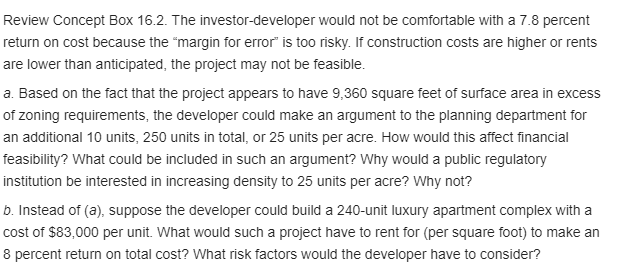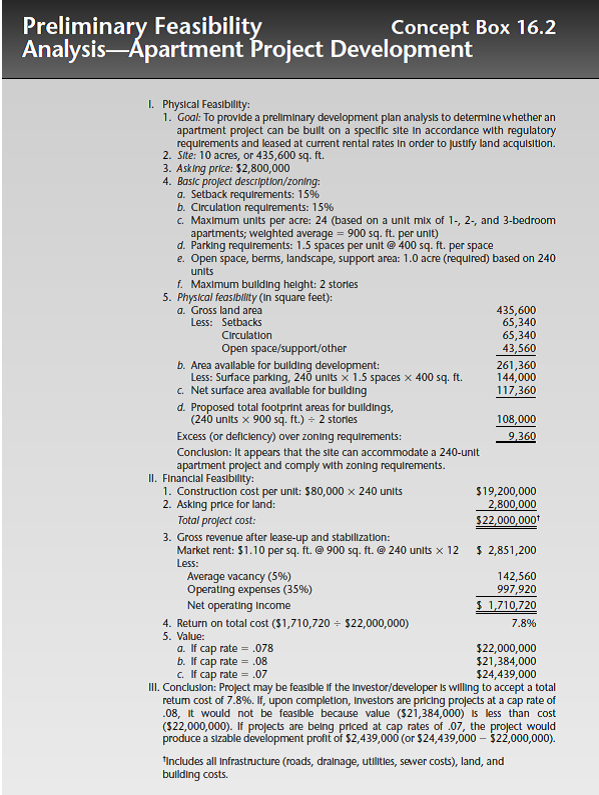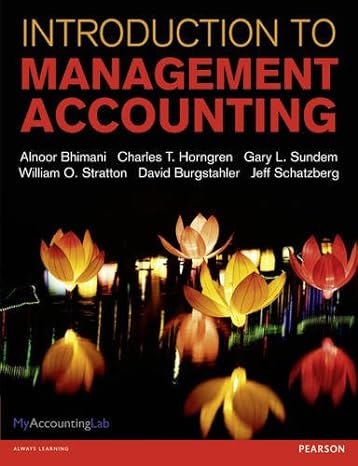

Review Concept Box 16.2. The investor-developer would not be comfortable with a 7.8 percent return on cost because the "margin for error" is too risky. If construction costs are higher or rents are lower than anticipated, the project may not be feasible. a. Based on the fact that the project appears to have 9,360 square feet of surface area in excess of zoning requirements, the developer could make an argument to the planning department for an additional 10 units, 250 units in total, or 25 units per acre. How would this affect financial feasibility? What could be included in such an argument? Why would a public regulatory institution be interested in increasing density to 25 units per acre? Why not? b. Instead of (a), suppose the developer could build a 240-unit luxury apartment complex with a cost of $83,000 per unit. What would such a project have to rent for (per square foot) to make an 8 percent return on total cost? What risk factors would the developer have to consider? Preliminary Feasibility Concept Box 16.2 AnalysisApartment Project Development 1. Physical Feasibility: 1. Goal: To provide a preliminary development plan analysis to determine whether an apartment project can be built on a specific site in accordance with regulatory requirements and leased at current rental rates in order to justify land acquisition. 2. Site: 10 acres, or 435,600 sq. ft. 3. Asking price: $2,800,000 4. Basic project description/zoning: a. Setback requirements: 15% b. Circulation requirements: 15% c. Maximum units per acre: 24 (based on a unit mix of 1., 2., and 3-bedroom apartments; weighted average = 900 sq. ft. per unit) d. Parking requirements: 1.5 spaces per unit @ 400 sq. ft. per space e. Open space, berms, landscape, support area: 1.0 acre (required) based on 240 units f. Maximum building helght: 2 stories 5. Physical feasibility (in square feet): a. Gross land area 435,600 Less: Setbacks 65,340 Circulation 65,340 Open space/support/other 43,560 b. Area available for building development: 261,360 Less: Surface parking, 240 units X 1.5 spaces x 400 sq. ft. 144,000 c. Net surface area available for building 117,360 d. Proposed total footprint areas for buildings, (240 units x 900 sq. ft.) = 2 stories 108,000 Excess (or deficiency) over zoning requirement 9,360 Conclusion: It appears that the site can accommodate a 240-unit apartment project and comply with zoning requirements. II. Financial Feasibility: 1. Construction cost per unit: $80,000 x 240 units $19,200,000 2. Asking price for land: 2,800,000 Total project cost: $22,000,000 3. Gross revenue after lease-up and stabilization: Market rent: $1.10 per sq. ft. @ 900 sq. ft. @ 240 units x 12 $2,851,200 Less: Average vacancy (5%) 142,560 Operating expenses (35%) 997,920 Net operating Income $ 1,710,720 4. Return on total cost (51,710,720 = 522,000,000) 7.8% 5. Value: a. If cap rate = .078 $22,000,000 b. If cap rate = .08 $21,384,000 c. If cap rate = .07 $24,439,000 III. Conclusion: Project may be feasible if the investor/developer is willing to accept a total return cost of 7.8%. If, upon completion, Investors are pricing projects at a cap rate of .08, it would not be feasible because value ($21,384,000) is less than cost (522,000,000). If projects are being priced at cap rates of .07, the project would produce a sizable development profit of $2,439,000 (or $24,439,000 - $22,000,000). Includes all Infrastructure (roads, drainage, utilities, sewer costs), land, and building costs








